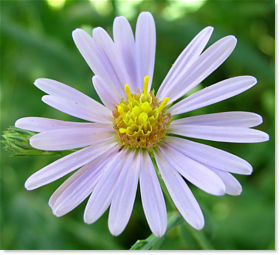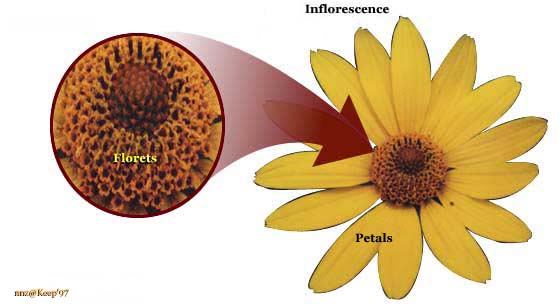
Asters - Fall Wildflowers!
| By Doug Collicutt | (Click links for more images.) |
 Smooth Aster
Smooth AsterManitoba's wildflower watching season starts each year with our floral emblem, the prairie crocus (Anemone patens) in late April. It ends in late September or early October when the last of the wild aster blossoms succumb to the frosty nights. From late August through September, and often well into October, asters dot our landscapes. Wherever you are in Manitoba, asters of one sort or another are the floral harbingers of autumn.
We have about 20 species of asters in Manitoba, depending on which source you choose to use and what the taxonomists have been up to lately. (You can see some of Manitoba's Asters on the next page of this article.) Asters of one species or another occur throughout the province and in nearly every type of habitat in our province, from wetlands and prairies to deciduous and coniferous forests. Most asters are small to medium sized plants (20-100 cm high) with leafy stems. They have numerous small flowers (usually <2 cm across) ranging from pure white to dark blue in colour.
|
Asters bloom late in the growing season, providing us with late-season flowers, but, more importantly, providing bees, butterflies and other insects with nectar and pollen as they prepare for winter. Asters flower late, but produce seeds rapidly. Each "flower" will produce a dandelion-like head of fluffy seeds.
Seed head of a Western Silvery Aster
(Symphiotrichum sericeum)
The seeds are tiny and are spread to the winds before the snow flies. If the seed comes to rest in favourable conditions it will germinate in the following spring. Most asters are good colonizers and will establish quickly in disturbed sites. Beware of establishing some types of asters in a garden setting. Species such as Smooth Aster (S. laeve)and Many-Flowered Aster (S. ericoides) are very aggressive and can take over large sections of your garden.
|
Origin of name:
Aster = star (Latin and Greek)
In both Latin and Greek, aster refers to star. Aster plants were named for the stars that they resemble in both shape and numbers, as opposed to sunflowers (Helianthus spp.) which have large, and less numerous, yellow, "sun-like" flowers.
Narrow-leaved Sunflower (Helianthus maximillianii)
Carry on for some of Manitoba's Asters![]()
Or check out our New Age Tale: Star Flower
| You can help NatureNorth produce more great articles with a secure donation through PayPal. Our Google Adsense ads pay our server costs, but that's about it. To learn more follow this link: Support NatureNorth. Thank-you! | |
Return to: Fall Issue | NatureNorth Front page

